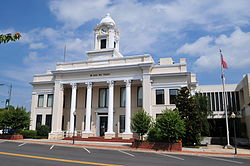
Davie County is a county located in the U.S. state of North Carolina. As of the 2020 census, the population was 42,712. Its county seat is Mocksville.

Mocksville is a town in Davie County, North Carolina, United States. The population was 5,900 at the 2020 census. I-40 leads west to Statesville and Hickory, and east to Winston-Salem and Greensboro. Route 64 heads east to Lexington, and west towards Statesville and Taylorsville. It is the county seat of Davie County.
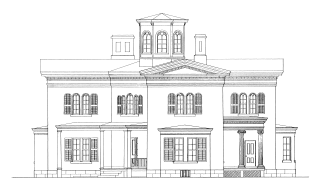
Cooleemee, also known as the Cooleemee Plantation House, is a house located between Mocksville and Lexington, North Carolina, at the terminus of SR 1812 on the Yadkin River in Davie County, North Carolina. It is a U.S. National Historic Landmark, designated in 1978 for its architecture.
Advance is an unincorporated community and census-designated place (CDP) in Davie County, North Carolina, United States. It is seventy-five miles northeast of Charlotte. As of the 2010 census it had a population of 1,138. It is located along North Carolina Highway 801 just south of Bermuda Run. Advance is part of the Piedmont Triad region of North Carolina.

The Hinton Rowan Helper House is a historic house on United States Route 64 outside Mocksville, Davie County, North Carolina. Built on land that once belonged to Daniel Boone, it was the childhood and early adult home of Hinton Rowan Helper (1829-1909) whose The Impending Crisis of the South was an influential antislavery work that inflamed tensions in 1860. The house was added to the National Register of Historic Places and declared a National Historic Landmark in 1973.

The Hyde County Courthouse is a historic courthouse building located at Swan Quarter, Hyde County, North Carolina. It was built in 1854–1855, and is a two-story, T-shaped stuccoed brick building. It has a Victorian style corbelled mousetooth cornice and ornately turned brackets. The courthouse was remodeled in 1878 and 1909 and drastically renovated in 1964.
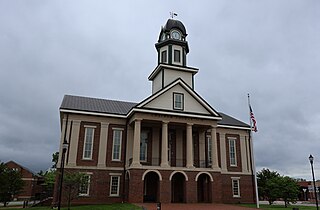
The Chatham County Courthouse is a historic courthouse located at Pittsboro, Chatham County, North Carolina. It sits at the center of town in the middle of a traffic circle. It was built in 1881 for $10,666 and is a two-story rectangular brick structure in the Late Victorian style. It features a two-story classical portico crowned with a distinctive three-stage cupola. A one-story addition was built in the 1930s by the Works Progress Administration. In 1959, extensive renovations were performed on the building.

The Henderson County Courthouse, also known as the Historic Henderson County Courthouse and the Old Henderson County Courthouse, is a historic 3-story brick gold-domed Classical Revival style courthouse building located at One Historic Courthouse Square, corner of 1st and Main streets in Hendersonville, North Carolina.

Halifax Historic District is a national historic district located at Halifax, Halifax County, North Carolina, US that was listed on the National Register of Historic Places in 1970. It includes several buildings that are individually listed on the National Register. Halifax was the site of the signing of the Halifax Resolves on April 12, 1776, a set of resolutions of the North Carolina Provincial Congress which led to the United States Declaration of Independence gaining the support of North Carolina's delegates to the Second Continental Congress in that year.

Davie County Jail is a historic county jail located at Mocksville, Davie County, North Carolina. It was built in 1839, and is a two-story, three-bay, brick building with a gable roof. It was used as a jail until 1909, then renovated for residential use.
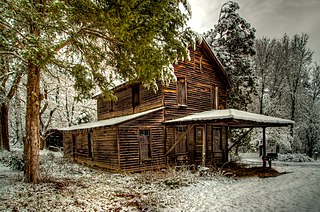
Cana Store and Post Office is a historic general store and post office building located near Mocksville, Davie County, North Carolina. It was built about 1875, and is a two-story, three-bay, frame building with a gable roof. The front facade features a broad hip-roofed frame canopy added in the 1930s that serves as a porte-cochere. Also on the property is a contributing one-story woodshed built in the 1930s. The building housed a post office until 1954 and a general store until 1965.
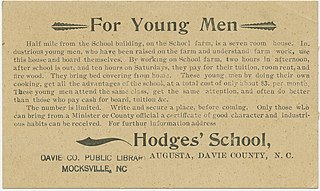
Hodges Business College, also known as Hodges School, is a historic school building located near Mocksville, Davie County, North Carolina. It was built in 1894, and is a two-story, rectangular, Gothic Revival-style brick building. It features multiple Gothic-arched window openings and front entrance. The building housed a school into the 1910s, then was converted to tenant house, and after 1936 used for storage. The building was converted to a residence in the 1990s.

Jesse Clement House is a historic home located at Mocksville, Davie County, North Carolina. It was built about 1828, and is a two-story, three-bay, vernacular Federal-style brick dwelling. It has a center hall plan.
McGuire-Setzer House is a historic home located near Mocksville, Davie County, North Carolina. The original section of the double-pen log building was built about 1825, with a frame section added about 1835. The dwelling is sheathed in weatherboard and is in a vernacular Federal style. It features gable end brick chimneys and rests on a stone foundation. Also on the property is a contributing kitchen building.
George E. Barnhardt House is a historic house located near Mocksville, Davie County, North Carolina. It is locally significant as a rare surviving example of a post-American Civil War brick farmhouse in Davie County.

North Main Street Historic District is a national historic district located at Mocksville, Davie County, North Carolina. The district encompasses 115 contributing buildings and 2 contributing sites in a linear residential section of Mocksville. It was developed between the 1840s and World War II and includes notable examples of Greek Revival, Italianate, Gothic Revival, Queen Anne, Classical Revival, Shingle Style, American Craftsman, Tudor Revival, and Colonial Revival style residential architecture. Also in the district are the First Methodist Church (1896), the Mocksville Graded School (1911), and the Masonic Picnic Grounds, established in 1883.
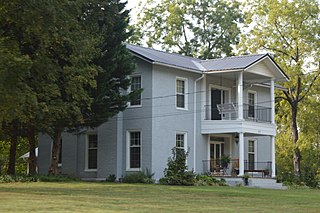
Salisbury Street Historic District is a national historic district located at Mocksville, Davie County, North Carolina. The district encompasses 40 contributing buildings in a predominantly residential section of Mocksville. It was developed between the 1820s and World War II and includes notable examples of Greek Revival, Italianate, Queen Anne, and American Craftsman style residential architecture. The dwellings are predominantly one- and two-story log and frame houses. Also in the district is the (former) Mocksville Academy.

Downtown Mocksville Historic District is a national historic district located at Mocksville, Davie County, North Carolina. The district encompasses 21 contributing buildings and 1 contributing object in the central business district of Mocksville. It primarily includes residential and commercial buildings with notable examples of Classical Revival and Beaux-Arts style architecture. The district includes the previously listed Davie County Courthouse. Other notable buildings include the Davie County Jail (1916), (former) C. C. Sanford Sons Store (1937), (former) J. T. Baity/Anderson Store, (former) Meroney Hardware Company Building (1922-1924), Sanford Brothers Building (1927), (former) Southern Bank &. Trust Company Building (1923), (former) Princess Theatre, J. T. Angell Building (1910), Horn Service Station, (former) Kurfees and Ward Pure Oil Station, (former) Meroney Filling Station, and Johnstone Office Building (1939).
Boxwood Estate is a historic hunting retreat and national historic district located near Mocksville, Davie County, North Carolina. The district encompasses 8 contributing buildings, 1 contributing site, and 4 contributing structures on a rural estate including a manor house. It was developed between 1911 and 1931 by William Rabb Craig (1870-1931), a wealthy cotton and sugar broker. The manor house was built between 1933 and 1934, and is a two-story, "H"-plan, brick Colonial Revival dwelling designed by the architectural firm Delano & Aldrich. Other notable resources include the grounds of Boxwood Lodge, greenhouse, log cabin, great barn (1910s), feed / grain house, and entrance piers (1934).
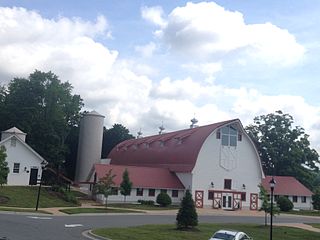
Win-Mock Farm Dairy is a historic dairy complex located at Bermuda Run, Davie County, North Carolina, USA. The complex was built about 1930 and includes a dairy barn, bottling plant, granary, cistern and water trough. The barn is a two-story frame building that measures 38 feet, 3 inches, in width by 180 feet in length. It has a concrete foundation, wood German-siding and a Gothic arch roof.
